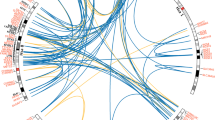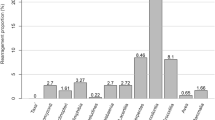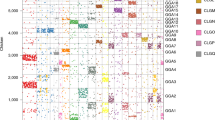Abstract
Susumu Ohno hypothesized that the diversity of vertebrate gene families and genome is due to two rounds of whole genome duplications (also referred as 2R hypothesis). The quadruplicate paralogous blocks present on 1/2/8/20 chromosomes are taken as one of the evidences in favor of the 2R. In this study, we investigated that whether 2R has shaped the vertebrate evolution using gene families residing on chromosomes 1/2/8/20. Evolutionary history of 22 gene families (11 from the current study and 11 from the previous study) was evaluated by the phylogenetic analysis with triplicated or quadruplicated distribution on these human chromosomes 1/2/8/20. The phylogenetic analysis was performed using high-quality whole genomic sequence data of multiple species with neighbor-joining (NJ) and maximum likelihood (ML) methods. The phylogenetic tree topology of these gene families revealed variable duplication time points during invertebrate–vertebrate evolution. Topology comparison approach categorized 22 gene families into three groups. Tree topologies of ten gene families fell into Group 1 (duplications prior to invertebrate–vertebrate split), four in Group 2 (i.e., (AB) (C) (D), topology incongruent with 2R) and eight in Group 3 (((AB) (CD)), 2R congruent topology). Therefore, taken together the current and previous data of 1/2/8/20 paralogons, we propose that, in addition to whole genome duplications events, current developmental, morphological and genomic complexity of the vertebrate genomes may also have originated through segmental duplications occurring at varying time points during the course of animal evolution.



Similar content being viewed by others
References
Abbasi AA (2008) Are we degenerate tetraploids? More genomes, new facts. Biol Direct 3:50
Abbasi AA (2015) Diversification of four human HOX gene clusters by step-wise evolution rather than ancient whole-genome duplications. Dev Genes Evol 225:353–357
Abbasi AA, Grzeschik K-H (2007) An insight into the phylogenetic history of HOX linked gene families in vertebrates. BMC Evol Biol 7:239
Abbasi AA, Hanif H (2012) Phylogenetic history of paralogous gene quartets on human chromosomes 1, 2, 8 and 20 provides no evidence in favor of the vertebrate octoploidy hypothesis. Mol Phylogenet Evol 63:922–927
Abi-Rached L, Gilles A, Shiina T, Pontarotti P, Inoko H (2002) Evidence of en bloc duplication in vertebrate genomes. Nat Genet 31:100–105
Ajmal W, Khan H, Abbasi AA (2014) Phylogenetic investigation of human FGFR-bearing paralogons favors piecemeal duplication theory of vertebrate genome evolution. Mol Phylogenet Evol 81:49–60
Asrar Z, Haq F, Abbasi AA (2013) Fourfold paralogy regions on human HOX-bearing chromosomes: role of ancient segmental duplications in the evolution of vertebrate genome. Mol Phylogenet Evol 66:737–747
Bailey JA, Eichler EE (2006) Primate segmental duplications: crucibles of evolution, diversity and disease. Nat Rev Genet 7:552–564
Bailey JA, Gu Z, Clark RA, Reinert K, Samonte RV, Schwartz S, Adams MD, Myers EW, Li PW, Eichler EE (2002) Recent segmental duplications in the human genome. Science 297:1003–1007
Cheng Z, Ventura M, She X, Khaitovich P, Graves T, Osoegawa K, Church D, DeJong P, Wilson RK, Pääbo S et al (2005) A genome-wide comparison of recent chimpanzee and human segmental duplications. Nature 437:88–93
Felsenstein J (1985) Confidence limits on phylogenies: an approach using the bootstrap. Evolution 39:783
Furlong RF, Holland PWH (2002) Were vertebrates octoploid? Philos. Trans R Soc Lond B Biol Sci 357:531–544
Gibson TJ, Spring J (2000) Evidence in favour of ancient octaploidy in the vertebrate genome. Biochem Soc, Trans, p 28
Gregory TR (2002) Genome size and developmental complexity. Genetica 115:131–146
Hafeez M, Shabbir M, Altaf F, Abbasi AA (2016) Phylogenomic analysis reveals ancient segmental duplications in the human genome. Mol Phylogenet Evol 94:95–100
Hokamp K, McLysaght A, Wolfe KH (2003) The 2R hypothesis and the human genome sequence. J Struct Funct Genom 3:95–110
Hughes AL (1998) Phylogenetic tests of the hypothesis of block duplication of homologous genes on human chromosomes 6, 9, and 1. Mol Biol Evol 15:854–870
Hughes AL (1999) Phylogenies of developmentally important proteins do not support the hypothesis of two rounds of genome duplication early in vertebrate history. J Mol Evol 48:565–576
Kasahara M (2007) The 2R hypothesis: an update. Curr Opin Immunol 19:547–552
Kehrer-Sawatzki H, Cooper DN (2008) Molecular mechanisms of chromosomal rearrangement during primate evolution. Chromosome Res Int J Mol Supramol Evol Asp Chromosome Biol 16:41–56
Larhammar D, Lundin L-G, Hallböök F (2002) The human Hox-bearing chromosome regions did arise by block or chromosome (or even genome) duplications. Genome Res 12:1910–1920
Lundin L-G, Larhammar D, Hallböök F (2003) Numerous groups of chromosomal regional paralogies strongly indicate two genome doublings at the root of the vertebrates. In: Meyer A, Van de Peer Y (eds) Genome evolution. Springer, Netherlands, pp 53–63
Martin A (2001) Is tetralogy true? Lack of support for the “one-to-four rule”. Mol Biol Evol 18:89–93
McLysaght A, Hokamp K, Wolfe KH (2002) Extensive genomic duplication during early chordate evolution. Nat Genet 31:200–204
Meyer A, Van de Peer Y (2005) From 2R to 3R: evidence for a fish-specific genome duplication (FSGD). BioEssays 27:937–945
Ohno DS (1970) Introduction in evolution by gene duplication. Springer, Berlin, pp 1–2
Ohno S (1973) Ancient linkage groups and frozen accidents. Nature 244:259–262
Saitou N, Nei M (1987) The neighbor-joining method: a new method for reconstructing phylogenetic trees. Mol Biol Evol 4:406–425
Sundström G, Larsson TA, Larhammar D (2008) Phylogenetic and chromosomal analyses of multiple gene families syntenic with vertebrate Hox clusters. BMC Evol Biol 8:254
Tamura K, Stecher G, Peterson D, Filipski A, Kumar S (2013) MEGA6: molecular evolutionary genetics analysis version 6.0. Mol.Biol Evol 30:2725–2729
Thompson JD, Higgins DG, Gibson TJ (1994) CLUSTAL W: improving the sensitivity of progressive multiple sequence alignment through sequence weighting, position-specific gap penalties and weight matrix choice. Nucleic Acids Res 22:4673–4680
Whelan S, Goldman N (2001) A general empirical model of protein evolution derived from multiple protein families using a maximum-likelihood approach. Mol Biol Evol 18:691–699
Wolfe KH (2001) Yesterday’s polyploids and the mystery of diploidization. Nat Rev Genet 2:333–341
Yang Z (1994) Maximum likelihood phylogenetic estimation from DNA sequences with variable rates over sites: approximate methods. J Mol Evol 39:306–314
Zhang J (2003) Evolution by gene duplication: an update. Trends Ecol Evol 18:292–298
Acknowledgements
Special thanks to the teams behind UCSC, NCBI and Ensembl genome browsers, for making all the data publically available for different analyses.
Author information
Authors and Affiliations
Corresponding author
Ethics declarations
Conflict of interest
Authors have no conflict of interests.
Electronic supplementary material
Below is the link to the electronic supplementary material.
Rights and permissions
About this article
Cite this article
Haq, F., Saeed, U., Khalid, R. et al. Phylogenetic analyses of human 1/2/8/20 paralogons suggest segmental duplications during animal evolution. 3 Biotech 9, 233 (2019). https://doi.org/10.1007/s13205-019-1768-7
Received:
Accepted:
Published:
DOI: https://doi.org/10.1007/s13205-019-1768-7




